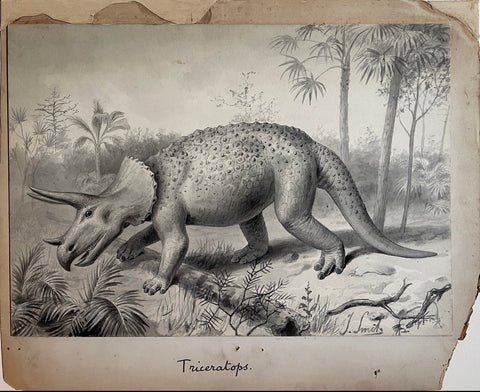
Joseph Smit (1836-1929), Triceratops (From remains found in Cretaceous strata of Wyoming, U.S.A.)
Joseph Smit (1836-1929)
Triceratops (From remains found in Cretaceous strata of Wyoming, U.S.A.)
Original Illustration in pen, ink and grey wash, heightened in white.
c. 1905-1912.
7 1/4 x 10 5/8 in. sheet
The Triceratops, the ‘three-horned face’ dinosaur, was a ceratopsian herbivorous dinosaur that lived in what is now the United States during the Late Cretaceous period, 68-66 million years ago. The African Elephant-sized dinosaur was among the last non-avian dinosaurs to evolve before the cataclysmic extinction event that occurred 66 million years ago. One of the most abundant dinosaurs unearthed by paleontologists, Triceratops has been found all across the fossil-rich Hell Creek Formation in northeastern Montana.
With its 3 horns, a parrot-like beak and a large frill that could reach nearly 1 metre (3 feet) across, the Triceratops skull is one of the largest and most striking of any land animal. The horns could have been used to fend off attacks from Tyrannosaurus. A partial Triceratops fossil collected in 1997 has a horn that was bitten off, with bite marks that match Tyrannosaurus. The fossil shows that the horn healed after being bitten, so at least some Triceratops survived these encounters. Puncture marks on fossil frills show that male Triceratops also used their horns to fight each other, probably to impress females.
Reference: Natural History Museum, 2021; Castro, 2016
JOSEPH SMIT (1836-1929)
Josef Smit’s dinosaur drawings are a high point in his fine draughtsmanship and unique in his vision to construct an image based on a written description rather than a physical specimen. Knipe’s preface indicates that Smit also learned much from Charles Knight’s drawings at the Museum of Natural History, New York.
Josef Smit was born and raised in Lisse, in southern Holland. Later, in Leiden, his scientific fidelity came to the Natural History Museum of Leiden director Hermann Schlegel’s attention. He presented the artist with his first commission to paint a series of birds from the Dutch East Indies. Smit’s work for Schlegel earned him a significant commission to prepare hundreds of plates for Philip Sclater’s Exotic Ornithology. Once in London, the artist met other like-minded artist-naturalists and developed a reputation for preparing very realistic drawings. Because of his ability to delineate every detail of a specific bird, he was employed by several scientists to illustrate their reports and publications. His work stood apart from his contemporaries in his addition of thorough backgrounds of leaves, vines, and tree branches. Smit eventually became a key contributor to some of the most important natural history publications of the 19th and early-20th centuries. His work graced the tomes by John Gould, Edward Lear, Archibald Thorburn, Henry Constantine Richter, and J.G. Keulemans. His son, Pierre-Jacques Smit was also a skilled watercolorist.
ORIGINAL WATERCOLORS PREPARED FOR HENRY KNIPE’S
NEBULA TO MAN (1905) & EVOLUTION IN THE PAST (1911-1912)
An exceedingly rare collection of original watercolors prepared for Henry Knipe’s Nebula to Man (1905) and Evolution in the Past (1911-1912) by naturalist-artists Alice Woodward, Josef Smit, and Charles Whymper.
Drawings prepared for Knipe’s Nebula to Man (1905) contributed to one of the most important publications on dinosaurs on the heels of the Great Dinosaur Rush or Bone Wars. The Bone Wars occurred between 1877 and 1892 between Edward Drinker Cope, the Academy of Natural Sciences Philadelphia, and Othniel Charles Marsh, the Peabody Museum of Natural History at Yale. These early paleontologists fought ruthlessly to pursue dinosaur fossils, a quest that resulted in an extraordinary period of discovery and the eventual financial ruin of both scientists. Their findings resulted in unearthing 136 new dinosaur species, ushering in a new paleontological research era.
According to Henry Knipe’s obituary, he worked for the British Museum. It was there that he likely met the artists tapped for this project. Knipe chose each illustrator for their reputation for scientific authenticity—namely, those skilled as bird artists, given the many similarities between bird species and dinosaurs.
We Also Recommend

![Albertus Seba (1665-1736) Tab I [Insects]](http://aradergalleries.com/cdn/shop/products/I_large.jpg?v=1635434052)
![Albertus Seba (1665-1736) Tab II [Insects]](http://aradergalleries.com/cdn/shop/products/II_large.jpg?v=1635434726)
![Albertus Seba (1665-1736) Tab III [Insects]](http://aradergalleries.com/cdn/shop/products/III_large.jpg?v=1635434877)
![Albertus Seba (1665-1736) Tab L [Insects]](http://aradergalleries.com/cdn/shop/products/L_b_large.jpg?v=1635435506)
![Albertus Seba (1665-1736) Tab L [Insects]](http://aradergalleries.com/cdn/shop/products/L_large.jpg?v=1635437893)